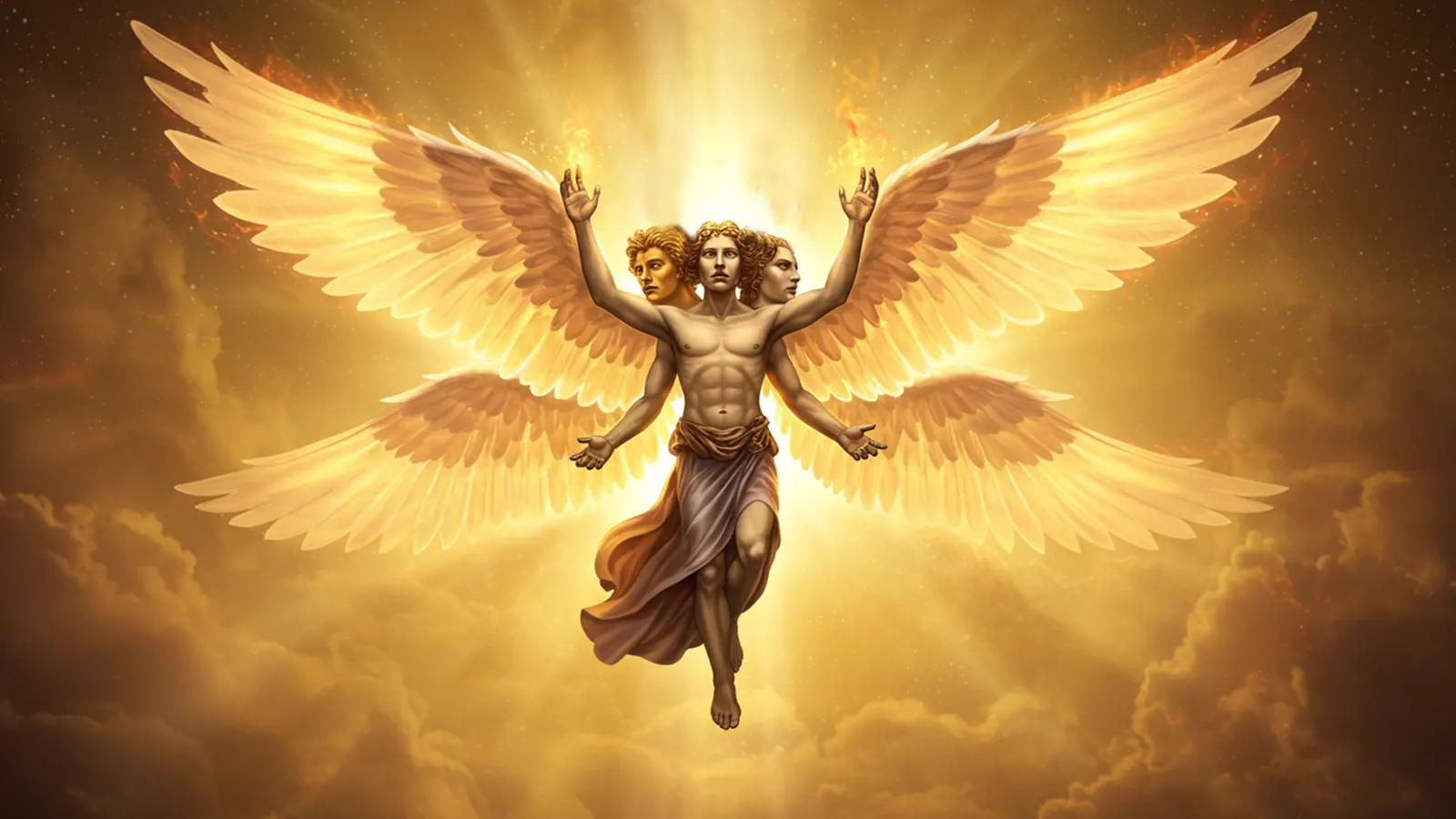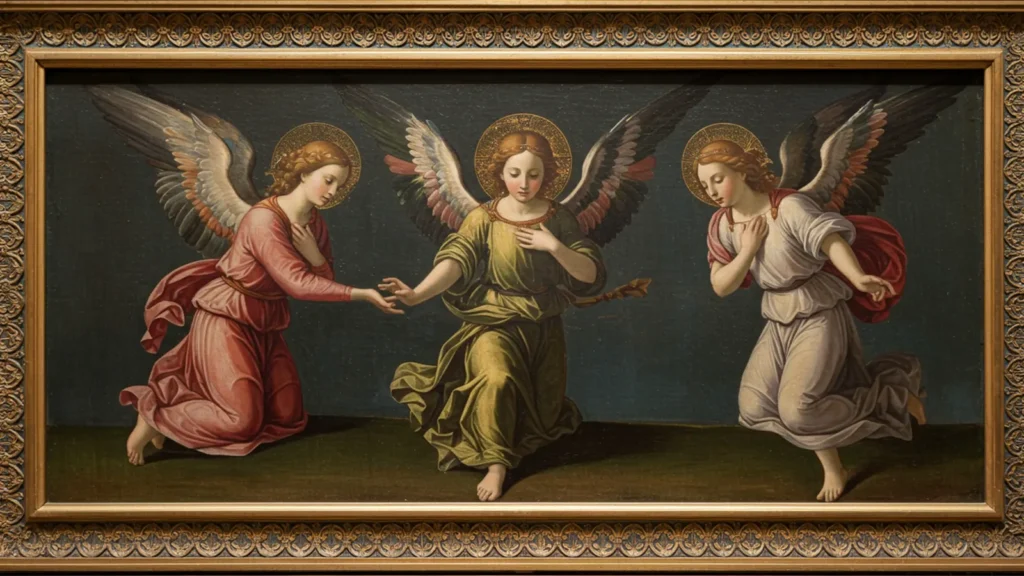The cherub is one of the most enigmatic and fascinating figures in the Scriptures. From the earliest books of the Bible to prophetic visions, cherubim appear as heavenly beings of great power, symbolizing the divine presence, holiness, and the guarding of God’s mysteries.
Table of Contents – Straight to the Point
Quick Summary
The cherub is a heavenly being of great prominence in the Scriptures, described as a guardian of God’s presence and a symbol of holiness. From Eden to prophetic visions, it is associated with protection, worship, and divine reverence.
Main points about the cherub:
- Guardian of the way to the tree of life in Genesis.
- Depicted on the Ark of the Covenant as a sign of the divine presence.
- Described in Ezekiel with multiple faces and wings.
- Linked to purity, wisdom, and watchfulness.
- Inspired art, culture, and symbolism throughout history.
What Is a Cherub?
The cherub is described in the Bible as an angelic being of elevated rank. Unlike messenger angels, its role is more closely tied to worship and the guarding of holy places. The term “cherub” comes from the Hebrew kerub, which may relate to the idea of “one who blesses” or “one who intercedes.”
In the Judeo-Christian tradition, the cherub appears as a protector of God’s glory, often depicted around the Ark of the Covenant, the temple, and in prophetic visions.
The Cherub in the Old Testament
The Cherub in Genesis
The first mention of the cherub is in Genesis 3:24, when God placed cherubim with a flaming sword to guard the way to the tree of life after the fall of Adam and Eve. Here, they appear as guardians of holiness and eternity.
The Cherub in the Tabernacle and the Temple
In the book of Exodus, God commands that two cherubim be carved over the Ark of the Covenant, representing the divine presence in the Holy of Holies. Their outstretched wings symbolized protection and God’s glory dwelling among the people.
The Cherub in Ezekiel
The prophet Ezekiel describes striking visions of cherubim (Ezekiel 10), highlighting their majestic appearance: beings with four faces (man, lion, ox, and eagle) and multiple wings, full of eyes and surrounded by fire. This description emphasizes the strength, intelligence, vigilance, and spiritual power of these beings.

The Cherub in the New Testament
Although the New Testament speaks more broadly of angels and archangels, the concept of the cherub also appears, mainly in reference to God’s throne. In Hebrews 9:5, Paul mentions the cherubim that overshadowed the Ark, reminding the people of the holiness of the divine presence.
In Revelation, there are living creatures that share similarities with the cherubim described by Ezekiel, reinforcing the idea that they are directly connected to worship and the heavenly throne.
Symbolism of the Cherub
The cherub carries profound meanings that span centuries of faith and tradition:
- Protection: guardians of holy places and of God’s presence.
- Worship: eternal worshipers before the divine throne.
- Wisdom: their multiple faces reflect knowledge and discernment.
- Purity: they represent untouchable, incorruptible holiness.
Where the Bible Talks About Cherubim
The theme of the cherubim appears in several biblical books, always linked to God’s presence, worship, and the guarding of the sacred. Below are key passages that mention these heavenly beings:
Genesis 3:24
After the fall of Adam and Eve, God placed cherubim with a flaming sword to guard the way to the tree of life. Here they appear as guardians of holiness and eternity.
Exodus 25:18–22
In the tabernacle, two cherubim of gold were set over the Ark of the Covenant, with outstretched wings covering the mercy seat. They symbolized God’s presence dwelling among the people.
1 Kings 6:23–28
In the temple built by Solomon, large figures of cherubim were carved from olive wood and overlaid with gold, positioned in the Holy of Holies.
Ezekiel 10
The prophet describes an astonishing vision of cherubim with multiple faces and wings, full of eyes and surrounded by fire. This passage is one of the most detailed regarding their appearance.
Psalm 18:10
The psalmist describes God “riding on a cherub,” a poetic image symbolizing divine power, majesty, and movement.
Hebrews 9:5
In the New Testament, the author recalls the cherubim that overshadowed the mercy seat of the Ark, connecting Old Testament symbolism to the Christian faith.

Cherub and Seraph: Differences
Often confused, the cherub and the seraph are distinct beings. The seraph is associated with fire and worship in Isaiah 6, while the cherub appears more closely linked to guarding and the presence of divine glory. Both, however, symbolize closeness to God and His majesty.
Artistic Representations of the Cherub
Over the centuries, the angelic figure described in Scripture has been reinterpreted in many ways by the visual arts. Since the Middle Ages, sculptors and painters began to include images of winged beings in churches, stained glass, and illuminated manuscripts, reinforcing the idea that they were guardians of the sacred. These representations ranged from majestic, imposing figures to more delicate forms closer to the popular imagination.
During the Renaissance, artists such as Raphael and Michelangelo popularized the image of small childlike angels with wings, known as “putti.” Although inspired by biblical traditions, these portrayals took on a more romantic and affectionate tone, conveying innocence, love, and purity. This version is still one of the most widespread in cards, decorations, and religious artworks.
As time passed, different styles offered new interpretations of this figure. In the Baroque period, for example, sculptures and paintings took on a more dramatic air, with intense expressions and gestures that conveyed emotion and reverence. In Neoclassicism, aesthetics turned toward an ideal of balance and harmony, softening the depiction of these heavenly beings.
Beyond churches and museums, iconography also found a place in folk art and handicrafts. Statuettes, wooden ornaments, and colorful stained glass still keep alive the tradition of portraying these guardians, blending religiosity with cultural aesthetics.
Despite the spread of a sweeter, childlike image, the biblical description points to a far more enigmatic and majestic appearance, full of symbols that go beyond delicacy. This gap between the Scriptures and what took hold in the arts highlights how culture shapes and reframes spiritual symbols over time.
The Cherub and Popular Culture
The heavenly figure that appears in Scripture has crossed the boundaries of religion and begun to influence different forms of cultural expression. In the classical art of the Renaissance, for example, it is common to find infant angelic representations with small wings, popularly called “little angels.”
These images were inspired by biblical descriptions, but took on a more delicate and romantic character, associated with tenderness and love.
In literature, writers of various eras used the image of these beings to symbolize purity, innocence, and even the guarding of spiritual secrets. Medieval and modern poets referred to them as guardians of the sacred, intermediaries between the human and the divine.
In music, especially in hymns and classical compositions, their presence is evoked as a representation of heavenly majesty, bringing the idea of continual praise and nearness to God. In contemporary songs, they often appear as a metaphor for innocence or invisible protection.
In film and series, these figures have also been adapted in varied ways: in some productions, they portray protective beings of light; in others, they appear as mysterious creatures, with forms closer to Ezekiel’s descriptions, stirring both fascination and awe.
In popular culture, therefore, the angelic image blends gentleness and strength. While remembered as a symbol of innocence and love, it maintains an aura of reverence, respect, and mystery, preserving the idea of nearness to the sacred and the grandeur of the spiritual realm.
Curiosities About the Cherub
- The cherub is mentioned about 90 times in the Bible.
- In biblical Hebrew, the plural is cherubim, but in the original it would be “kerubim.”
- They appear both in prophetic visions and in practical instructions for the tabernacle.
- Many rabbinic traditions affirm that the cherub relates to the heavenly order closest to the divine throne.
Frequently Asked Questions
What Does the Word “Cherub” Mean?
The word cherub means guardian or intercessor, used to designate heavenly beings who guard and represent the divine presence.
Are the Cherubim Angels?
Yes, cherubim are a class of angels, but they have different functions from messenger angels. They stand out for their closeness to God’s glory.
What Is the Difference Between Cherub and Seraph?
The cherub is linked to guarding and protection, while the seraph is connected to incessant praise and purification by fire.
Where Do the Cherubim Appear in the Bible?
They appear in Genesis, Exodus, Ezekiel, Hebrews, and Revelation, always related to the throne and the presence of God.
Do the Cherubim Have a Human Form?
The Bible describes cherubim with multiple faces and wings— a symbolic, spiritual figure not limited to a human form.
Conclusion
The figure of the cherubim runs through the Bible, religious tradition, and culture over the centuries, carrying mystery, beauty, and spiritual depth. More than simple angelic images, they represent the presence of God, purity, and reverence before the sacred.
Whether in the pages of Scripture, in the stained glass of ancient cathedrals, or in modern arts, their essence remains as a reminder that the divine is not distant, but near and active. Studying these representations helps us understand not only faith, but also how different generations translated their quest for the transcendent into symbols.
Thus, reflecting on the cherubim is also reflecting on humanity’s own relationship with mystery, with the sacred, and with the eternal need for protection and worship.
READ ALSO:
- Explanation of Psalm 121
- Prayer to Saint Anthony: A Powerful Devotion
- Psalm 67: Meaning and Spiritual Uses
FOLLOW US ON FACEBOOK